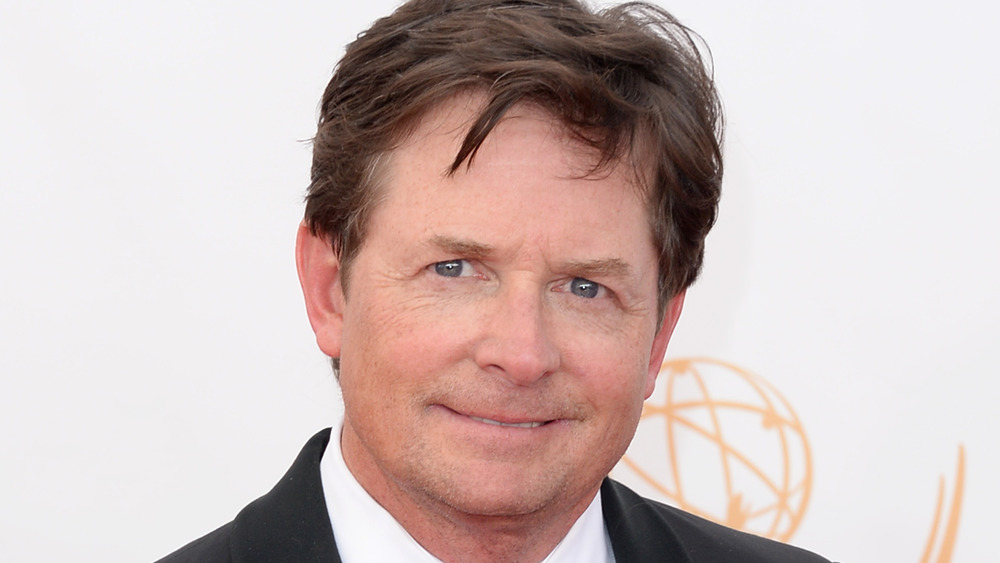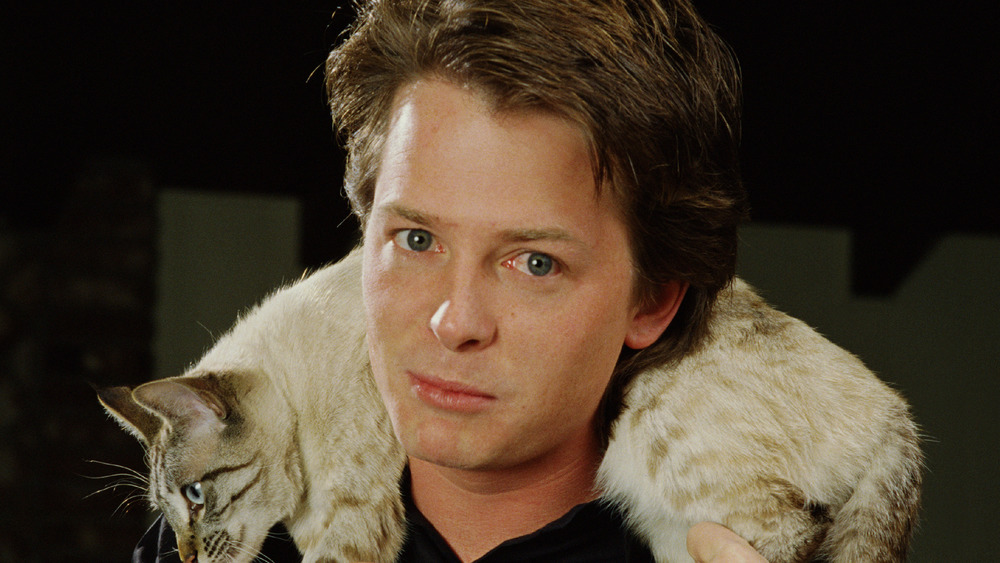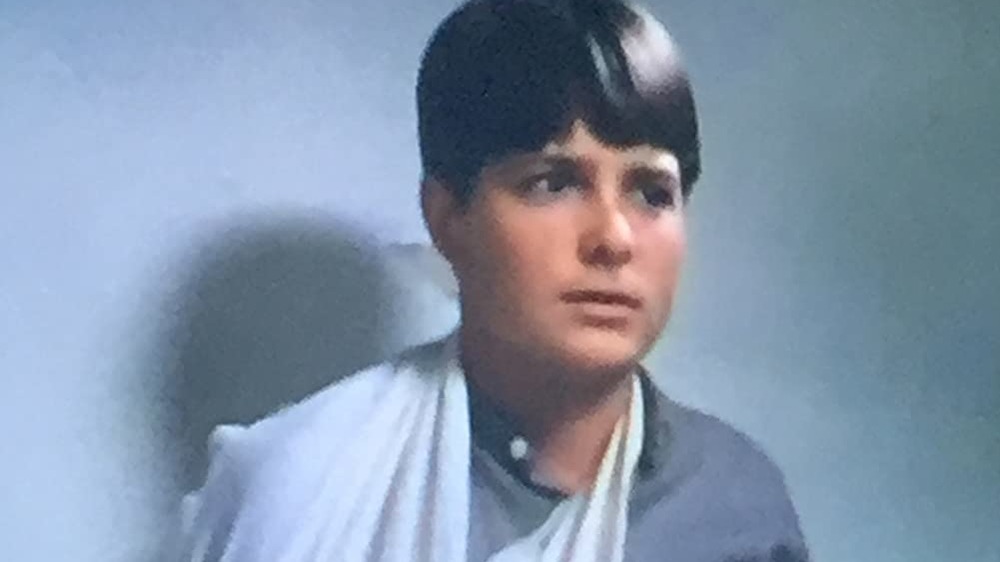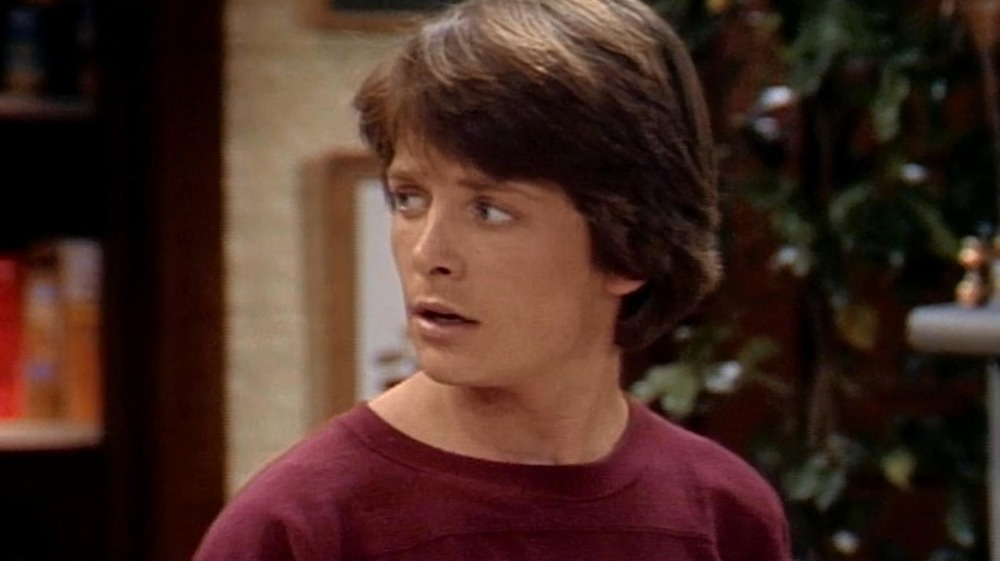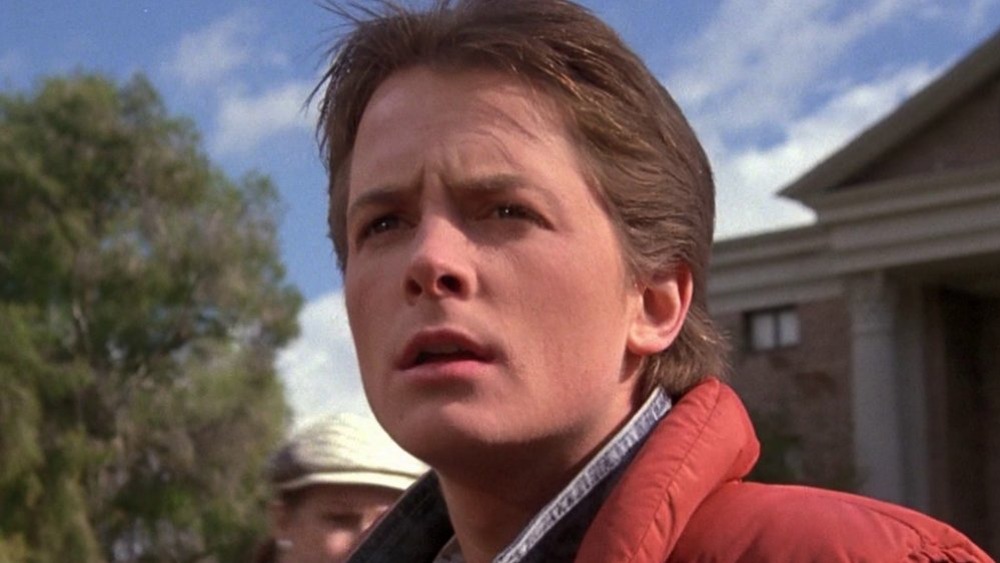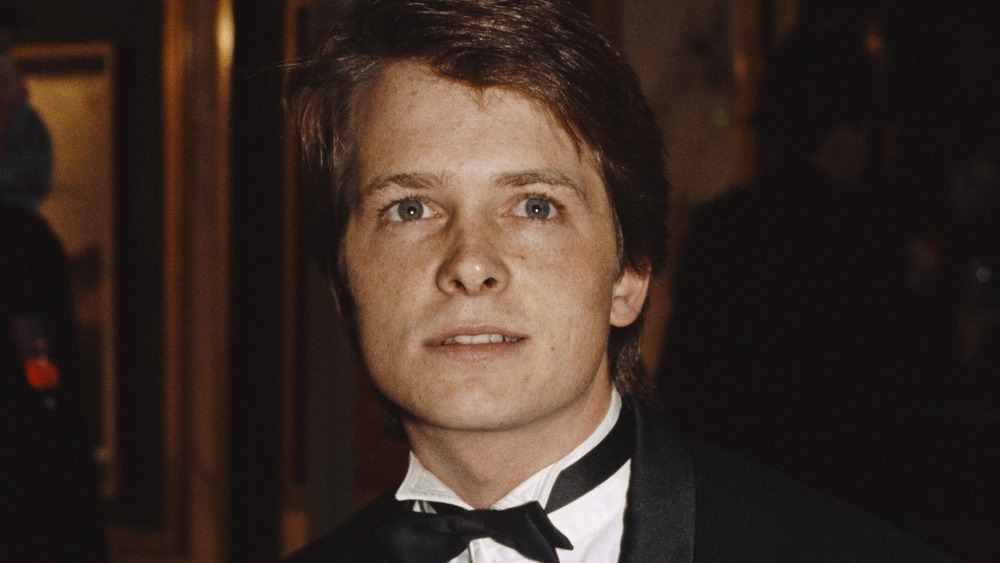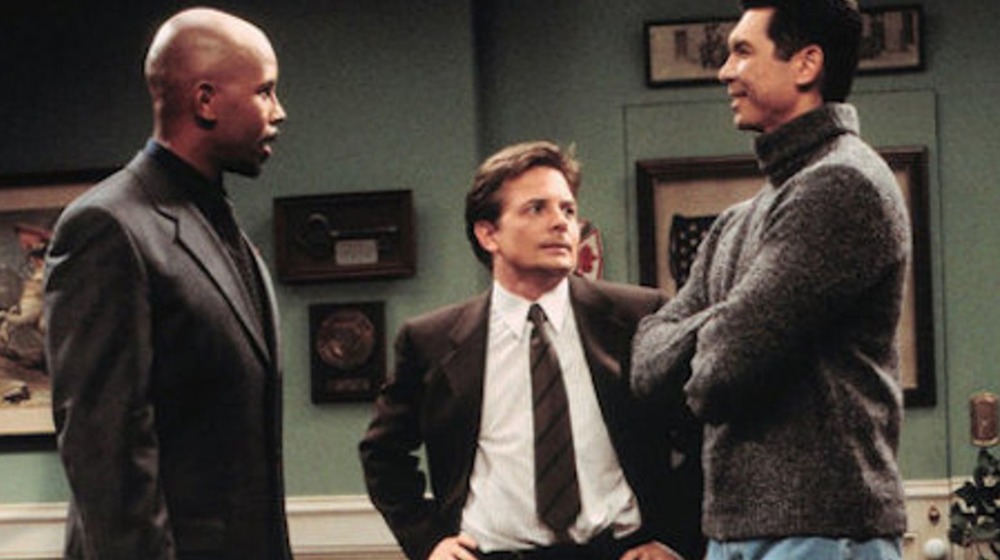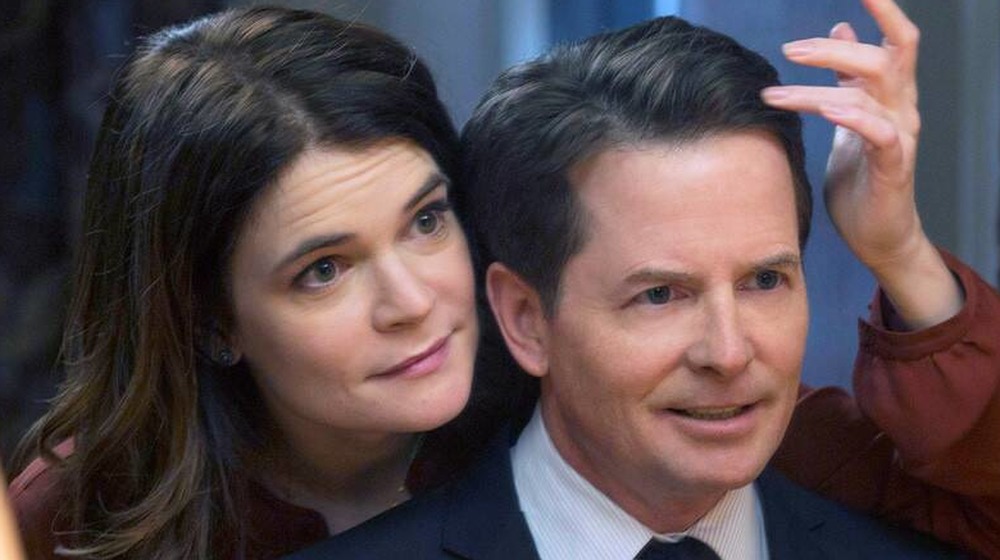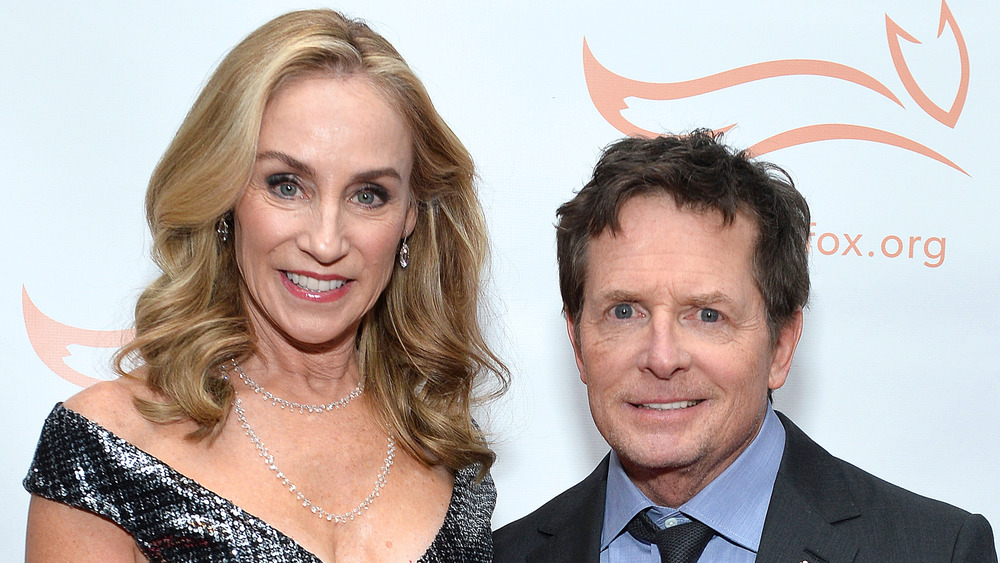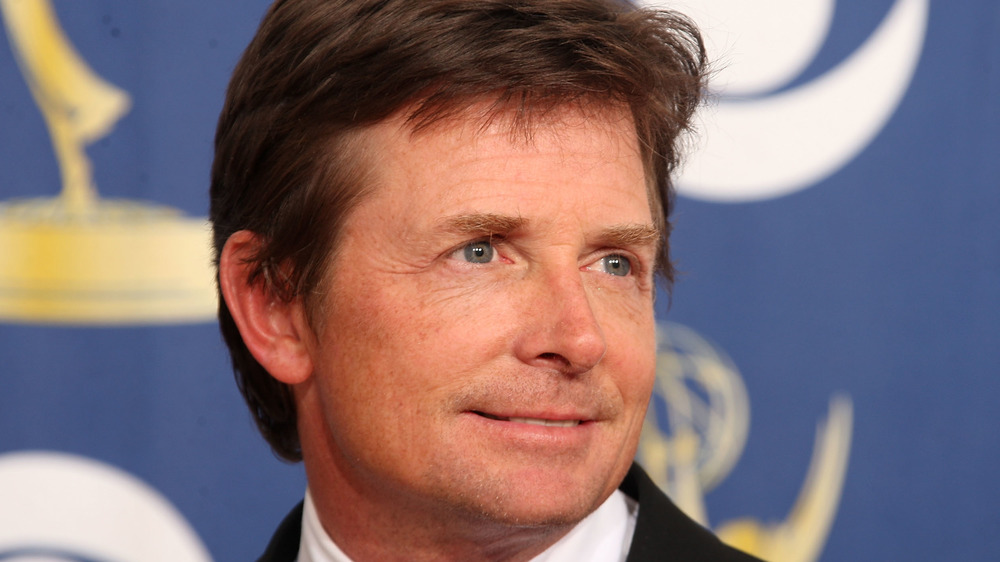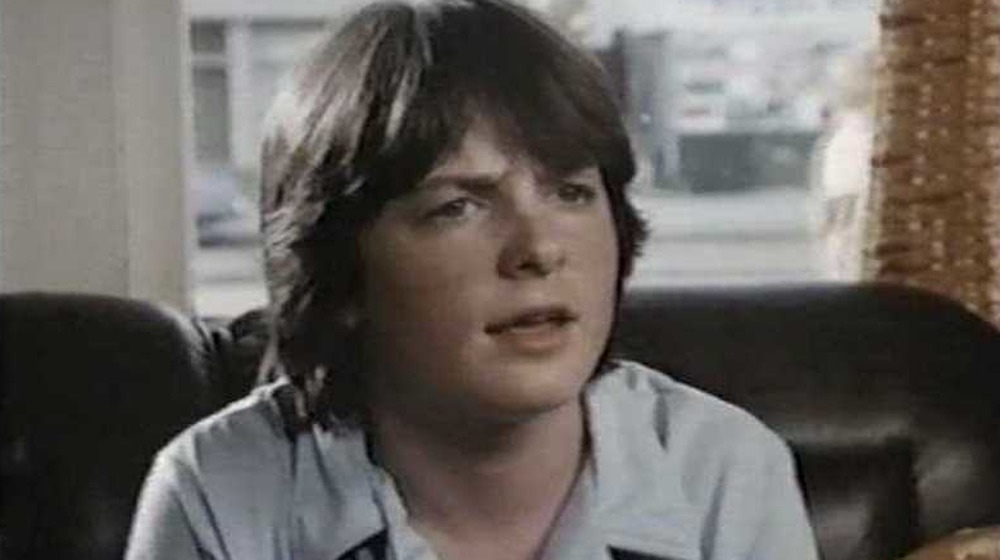The Untold Truth Of Michael J. Fox
It would be difficult to find an avid moviegoer or television viewer of the past 40 years who didn't harbor a deep fondness for Michael J. Fox. He's an absolute legend of 1980s pop culture thanks to a wide variety of roles in which he was always extremely charming. He'll forever be associated with definitive films of the era, such as Teen Wolf, The Secret of My Success, and most of all, Back to the Future. Who else but Fox would've been convincing as incredulous, guitar-toting teen Marty McFly, who gets sent back in time to the '50s and avoids the romantic advances of his own mother?
On top of that, Fox will always be strongly associated with television. After all, he became a star portraying Alex P. Keaton on Family Ties, and he had a long run on the political comedy Spin City as New York deputy mayor Mike Flaherty. And then, he turned in memorable and acclaimed guest arcs on Rescue Me and The Good Wife. With a career that prodigious and with a celebrity this beloved, you know there's more than meets the eye when it comes to this Canadian-American star. So, let's fire up the DeLorean, go back in time, and look at the untold truth of Michael J. Fox. Sha-la-la-la.
The story behind Michael J. Fox's middle name
Including a middle initial in one's professional or stage name just sounds good sometimes. It adds a certain rhythm or musicality to a name that might be a bit bland or unmemorable without that extra oomph, and it also adds a bit of gravitas generally reserved for world leaders and authors. Actors like Michael C. Hall, George C. Scott, and John C. Reilly certainly command more respect when their names evoke initial-based giants like Harry S. Truman or Ursula K. Le Guin.
Arguably the most famous actor who uses his middle initial is Michael J. Fox. It just kind of rolls off the tongue. However, he initially didn't intend to go that route, but when he started booking acting gigs and could join the Screen Actors Guild, which requires a unique name listing for every member, he found that there was already an actor named Michael Fox. The usual solution for actors in that situation is to throw in a middle initial or name, so Fox played around with Michael Andrew Fox and Michael A. Fox. That's right — his real middle name doesn't even start with a "J." However, he didn't like the sound of Andrew, and the "A" sounded too much like the Canadian phrase "eh" or could make his name into the embarrassing phrase "Michael is a fox," so he selected "J" in honor of Michael J. Pollard, an actor whose work he liked in the 1967 film Bonnie and Clyde.
Michael J. Fox's earliest roles were a blessing and a curse
In 1979, 18-year-old Michael J. Fox left his native Canada to pursue opportunities in the more robust U.S. entertainment industry. He quickly landed a role in the TV movie Letters from Frank, followed by parts on shows like Family, Lou Grant, and Trapper John, M.D.
Fox's first truly big break came when he was cast as Willy-Joe Hall on the Depression-set, racial tolerance drama Palmerstown, U.S.A. Created by Roots author Alex Haley, Palmerstown, U.S.A. debuted on CBS in the spring of 1980. Sadly, the show had a hard time finding an audience. In its first season, it aired opposite ABC's popular Mork and Mindy, and in season two, the competition was ABC's Happy Days.
Unfortunately for Fox, he was so locked into the strict schedule of filming the weekly drama that he missed out on the chance to act in other things. For example, Paul Newman directed a TV version of the Pulitzer Prize-winning play The Shadow Box in 1980 and wanted Fox to star. The young actor had even already appeared in the Vancouver production. But Fox couldn't do it because Palmerstown, U.S.A. producer Norman Lear wouldn't let him leave the show. Around that same time, Fox came close to landing the lead role in Ordinary People, but instead, it went to Timothy Hutton ... and it won him an Academy Award.
He fought for his role on Family Ties
Michael J. Fox found fame — and three Emmy Awards — for his work as Alex P. Keaton on Family Ties. The show was a top 10 smash, and while it adhered to the usual family-based sitcom formula, it offered a new, only-in-the-'80s spin. Parents Steven (Michael Gross) and Elyse Keaton (Meredith Baxter) were die-hard hippies in the '60s, and years later, they move to the suburbs of Columbus, Ohio, to raise a family. That includes their son, Alex, their political opposite in that he's a Ronald Reagan-worshipping Republican and conservative policy wonk.
Fox brought likability and depth to a character that, on the page, was a little cold and one-note, and it's hard to imagine anyone else but him inhabiting the role. Producers initially wanted fellow '80s teen idol Matthew Broderick for the part, but it didn't work out, so Fox got the job.
However, NBC president Brandon Tartikoff didn't think Fox was right for the role. He told Family Ties creator Gary David Goldberg that Fox didn't have the kind of face one would see on a lunchbox — a major marketing concern for kid-friendly shows in the early 1980s. Goldberg resisted his boss' machinations and cast Fox anyway. After Fox became a superstar, he sent Tartikoff a lunchbox with his face on it and a note that read, "Brandon, they wanted me to put a crow in here, but ... love and kisses, Michael J."
He almost didn't get to play Marty McFly
By the time Back to the Future entered pre-production in the mid-1980s, Michael J. Fox was a huge TV star thanks to his role as highly motivated Reaganite Alex P. Keaton on the hit NBC sitcom Family Ties. And the Back to the Future filmmakers thought Fox would be perfect to play their movie's main character, hard-rocking teen Marty McFly, who goes back in time to the 1950s to ensure that his parents wind up together and that he and his siblings don't subsequently disappear from existence. Producer Bob Gale and director Robert Zemeckis — both of whom co-wrote the script — put Fox at the top of their Marty McFly list, and they reached out to him to offer the role, but he had to decline. Family Ties executive producer Gary David Goldberg wouldn't give him the large amounts of time off necessary to go film the potential blockbuster.
So, the filmmakers had to move on, and they cast Eric Stoltz as Marty McFly and shot a few scenes before they realized they'd made a mistake, and that he wasn't right for the part. Production on Back to the Future temporarily halted and ultimately had to restart with a new Marty McFly. The actor Gale and Zemeckis hired? Michael J. Fox. This time, Goldberg allowed Fox to go film Back to the Future, so long as he didn't miss anything at Family Ties. Fox shot both simultaneously, often leaving one set to head directly to the other, which didn't leave much time for things like sleep.
Michael J. Fox's big secret in the '80s
As a teen idol in the relatively conservative 1980s, Michael J. Fox projected an image of wholesomeness and healthfulness. The short, baby-faced actor always appeared much younger than he was — he was 21 when he began playing strait-laced, put-together high schooler Alex P. Keaton on Family Ties — and his characters rarely engaged in anything untoward on-screen. (In a 1950s-set scene in Back to the Future, Fox's Marty McFly even tries, in vain, to order a sugar-free soda.)
Nevertheless, away from the prying eyes of television and movie cameras, Fox was an adult who engaged in adult-type behavior, like puffing on cigarettes. In 1987, he posed for a photograph to accompany a feature in Rolling Stone, and he allowed himself to be depicted smoking for the first time. "It required trust between me and him," photographer Deborah Feingold told the Chicago Tribune. "I think he knew the Rolling Stone audience could accept that part of him. But he didn't want me to re-sell the photograph to a teen magazine. He showed great concern because of the image he has."
According to Rolling Stone, Fox would smoke on set all day. The Back to the Future prop masters built an ashtray stand that allowed him to light up between takes, and the entrance to the kitchen on Family Ties was apparently covered with cigarette butts, just off camera, all courtesy of Fox.
His movie career led to his TV career
After Family Ties ended its seven-year run in 1989, Michael J. Fox was free to pursue his burgeoning film career full-time. As a result, Fox starred in a wide span of movies that varied in content, critical acclaim, and financial success. Back to the Future Part II and Back to the Future Part III were certified blockbusters, while traditional comedies like Doc Hollywood, Life with Mikey, and Greedy did respectable business.
In 1995, Fox took on a rare supporting role in The American President, a romantic comedy written by Aaron Sorkin and directed by Rob Reiner about a widowed commander-in-chief (Michael Douglas) falling in love with an environmental lobbyist (Annette Bening). Not only did it allow Sorkin to dip his toes into presidential fiction that would culminate in The West Wing, but the movie directly led to Fox's next big role and his return to the sitcom world.
In The American President, Fox played the White House's chief of staff, and on Spin City, he portrayed a similar role, the deputy mayor of New York City. Sweetening his decision to go back to TV was the fact that Fox wanted a gig that would keep him closer to home and working less hours. After all, he'd just been off in New Zealand for seven months filming The Frighteners. "The idea of a regular job sounded pretty good," Fox said (via The Buffalo News).
His big TV comeback didn't work out
With Family Ties and Spin City to his name, any return of Michael J. Fox to regular series television was bound to be a big deal. It was particularly eventful in the early 2010s, when Fox decided to get back to the grind of making a TV show every week after he'd left Spin City in 2000 when the symptoms of his Parkinson's disease made that job too physically taxing.
In 2012, Fox teamed up with Easy A writer Will Gluck to develop a new sitcom, and they put out feelers. According to Vulture, a bidding war ensued between ABC and NBC. The former offered Fox's future show the plum, post-Modern Family time slot. NBC did the competition one better, telling Fox that he could shoot the show in New York where he lived (not Los Angeles), and that they'd give him a full, 22-episode order immediately, and he wouldn't even have to shoot a pilot.
Fox went with NBC, and in September 2013, the heavily hyped The Michael J. Fox show debuted. Fox starred as Mike Henry, a version of himself in that the character was a successful father coping with Parkinson's disease. The public's response? Tepid. The first episode garnered 7.5 million viewers, most of whom never returned. Ratings steadily and aggressively fell, with episode 14 attracting fewer than 2 million people. After 15 of the 22 contracted episodes aired, NBC canceled The Michael J. Fox Show.
Michael J. Fox married his costar
Michael J. Fox has been married exactly once, and he still is — to actress Tracy Pollan. The couple wed in 1988, and at 30-plus years, they've enjoyed one of the longest-lasting Hollywood marriages on record. Their real-life romance followed a fictional one, but it took a while. Pollan landed a recurring role on Family Ties in 1985 as Ellen Reed, a love interest for Fox's character, Alex P. Keaton. When not filming together during Pollan's two-year stint on the show, they didn't hang out, as Pollan was in a long-term relationship with Kevin Bacon, and Fox had taken up with The Facts of Life star Nancy McKeon.
But by late 1987, things moved from the professional to the personal. After Bacon met future wife, Kyra Sedgwick, on the TV movie Lemon Sky, he and Pollan split, and Pollan took a role in the film Bright Lights, Big City, reuniting her with Fox. And soon, they fell in love. By the time Bright Lights, Big City hit theaters in 1988, Fox and Pollan were engaged.
Another real-life ramification of the Alex-Ellen love story? It gave a big boost to the career of struggling rock band Billy Vera and the Beaters. The group released the soulful ballad "At This Moment" in 1981, but it flopped on the pop chart. Then Family Ties used it as Alex and Ellen's special song. In early 1987, it hit #1 on the Billboard Hot 100.
Michael J. Fox's long battle with Parkinson's disease
In 1990, 29-year-old Michael J. Fox noticed one day that his pinkie finger was uncontrollably vibrating. It was a minor thing, and he thought little of it, and as he was a drinker, he attributed it to a hangover, according to The Guardian. But the actor kept experiencing other odd events, and in 1991, he saw a doctor. That's when Fox learned the devastating news — he had Parkinson's disease, a degenerative disorder of the brain that leads to the body shaking and going stiff, making it difficult for sufferers to walk or maintain balance.
At first, as Fox told Closer Weekly, he "responded by drinking too much." As he explained, "I drank to obliterate it, to make it go away." With his addiction leading to friction in his marriage, Fox quit drinking and sought treatment for his Parkinson's symptoms. Still, he kept working in films and on television, not publicly disclosing his Parkinson's diagnosis until 1998. In 2000, his symptoms forced him to scale back his schedule, which included walking away from his ABC sitcom, Spin City.
Ever since, he's balanced acting with advocacy, through The Michael J. Fox Foundation for Parkinson's Research. In 2020, Fox announced that his condition had started to seriously affect his ability to speak clearly and learn his lines. "My short-term memory is shot," he told People, adding, "The last couple of jobs I did were actually really word-heavy parts. I struggled during both of them."
A look at Michael J. Fox's very first TV show
Most Michael J. Fox fans probably remember seeing the actor for the first time in American productions like Family Ties or in Back to the Future. However, the actor began his professional career outside the U.S. and long before the mid-'80s, landing a lead role at age 15 (under the name "Mike Fox") in the Canadian sitcom Leo and Me. Fox was the "me," portraying 12-year-old Jamie, younger brother of teenager Leo (Brent Carver). There are some strange quirks associated with Leo and Me, starting with its timeline. It was produced in 1976, but it didn't air in Canada, on the CBC, until 1981.
However, there's a far more serious mystery that involves the short-lived comedy. According to the Seattle Post-Intelligencer, in 2002, it came to light that four people who worked on the show were later diagnosed with Parkinson's disease — Fox and three crew members, including director Don Williams. Parkinson's isn't thought to be a communicable disease, so the notion of a cluster of cases is both tragic and bizarre. The rate of Parkinson's diagnoses in the population at-large is 1 in 300, but among Leo and Me employees, it's about 1 in 30.
